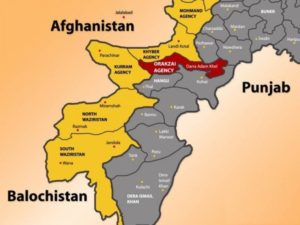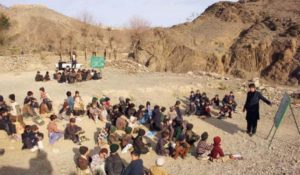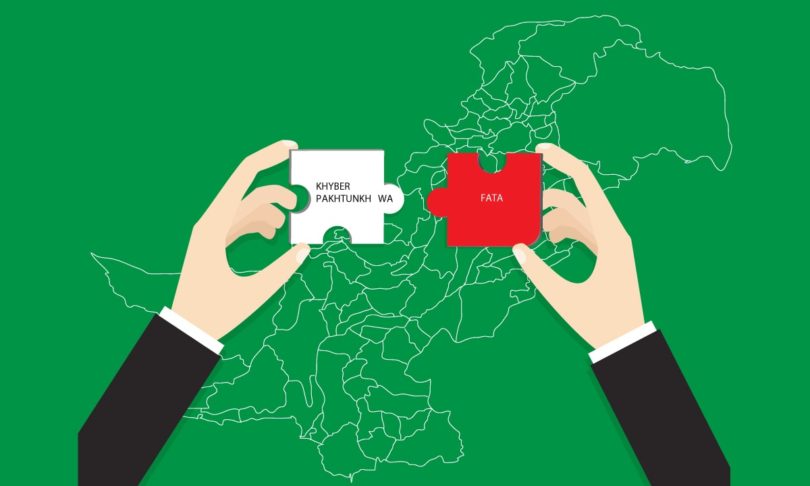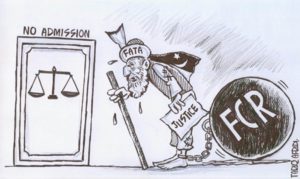By Lal Khan & Javed Iqbal
The situation in Federally Administered Tribal Area (FATA) in the north western Pakistan has been simmering in the last months. The British imperialists called these badlands and consequently carved the region to contain the Pushtoon tribes straddling across their imposed Durand Line of 1893. Colonial Raj indirectly ruled FATA brutally through the Frontier Crimes Regulation (FCR), first promulgated in 1872. It has been in effect until very recently. The FCR was designed to exclude the FATA’s inhabitants from the British colonial judiciary. Under this archaic FCR, an innocent individual could be imprisoned for the crimes of their relatives. Families were subjected to collective punishment, the government could displace entire villages without compensation, explanation, or warning and individuals would languish behind bars for years without any charges being filed.
 The Pakistani state continued with the dreaded FCR after its creation in 1947 and over the last 70 years. Its military had a free reign in the region. The anti-terrorist operations have inflicted a dreadful collateral damage. Hundreds of thousands have been forced to leave their homes, villages and bazaars detonated or bombed into ruins, thousands killed and maimed in this crossfire. Many thousands according to the locals have been abducted and are missing in suspicion of supporting the Taliban. However, in the last few months, there has been a controversial debate amongst Pakistan’s political elite of merging FATA with Khyber Pakhtunkhwa (KPK).
The Pakistani state continued with the dreaded FCR after its creation in 1947 and over the last 70 years. Its military had a free reign in the region. The anti-terrorist operations have inflicted a dreadful collateral damage. Hundreds of thousands have been forced to leave their homes, villages and bazaars detonated or bombed into ruins, thousands killed and maimed in this crossfire. Many thousands according to the locals have been abducted and are missing in suspicion of supporting the Taliban. However, in the last few months, there has been a controversial debate amongst Pakistan’s political elite of merging FATA with Khyber Pakhtunkhwa (KPK).
On Thursday Pakistan’s National Assembly in an extraordinary unity of the squabbling political parties, approved the 31st Amendment Bill 2017 to the 1973 Constitution for the merger of FATA with Khyber-Pakhtunkhwa (KPK). However, the Jamiat Ulema-e-Islam and Pakhtunkhwa Milli Awami Party opposed the bill and staged a walkout from the session. Their vested interests seemed to be in disparity to those of the other mainstream parties and their bosses on the issue of resolution the FATA’s turmoil. But the high level meeting of the military establishment and the government ensured the passage of this bill.
The passage of the bill became necessary after last year’s autumn of the last year when an unprecedented movement of the FATA’s youth, demanding basic human freedoms and rights for the ordinary inhabitants of the region, erupted ‘out of the blue’ and shook even the metropolitans centres of Pakistan. The extrajudicial murder of a Pashtoon Naqeeb Ullah Mehsud in Karachi by the police accentuated the revolt. Hundreds of thousands of Pashtuns from were mobilised by this upsurge and thronged to the public rallies to protest against the killing of Naqeeb and supporting the demands of the PTM. These include putting an end to discriminatory treatment of the ordinary people of the tribal areas; ending the humiliations and harassment particularly of the tribal women by the security forces at the check posts; recovery of the missing people picked up covertly; the removal of hazardous landmines from the tribal areas and rebuilding their destroyed dwellings in the so-called collateral damage during the military operation. The regime and the military establishment were caught unawares and baffled by the intensity and the depth of the rapidity and vigour of the movement. Hence all media outlets particularly electronic media have capitulated to a complete blackout of the movement. The deep state has resorted to stealth repression. The movement kept on gaining support and has had some of the largest rallies of any indigenous grassroot movement in the last few decades. It is far from finished.
Durand Line
FATA played a strategically crucial role since British colonial times. This region was used as a buffer zone between Russian Czars and The British Empire during their ferocious “Great Game.” Due to this growing territorial threat and the inadvisability of outright war with the vast Russian Imperial empire the British colonialists finally concluded a treaty with their puppet Afghan King to confine these peoples in an administrative and political structure in 1849 that they would not include in the Indian empire but it would indirectly control these rebellious and valiant tribes.
By the 1880s the Russians had advanced further and were pressing on the river Oxus and Afghanistan itself. By 1893, the British had concluded that formal borders needed to be established between Afghanistan and British India so that everyone would know where they stood and the Russian advance could be held off from the British Empire in India. The man sent to negotiate was the Indian Foreign Secretary, Sir Henry Mortimer Durand. His main concern was to secure Afghanistan’s northern border with Russia. A first settlement had been made in 1885 using the Oxus River but the boundary had not been taken all the way east into the region of the Pamirs and the Wakhan. Durand was desperate to make sure that this part of the border was absolutely clear so that the Russians could not sneak down through the Pamir Mountains into northern India. The 1900-mile long boundary Line, as demarcated between 1893 and 1896, was drawn all the way from the Persian frontier to the Wakhan, the little area on which the British insisted to keep a distance between the British and Russian Empires.
The Durand line cuts tribes and tribal groups in half. The Birmal district of Waziristan is on the Afghanistan side, with the rest of Waziristan was on the British and later on Pakistani side. The Line splits at least 12 villages in half and divides other villages from their agricultural territories. The Mohmand tribal areas are also cut in two. And, inevitably, because the border is generally in a very distant set of areas, it is highly porous and difficult to police, especially when family groups live on both sides of this line. Particularly in Waziristan, there are many passes and paths through which it was easy to move from British India or what now is divided into Pakistan and Afghanistan.
The British also created defensive buffer regions along India’s western borders to stymie Russian advancement and influence. The British adopted a three-tiered approach to India’s security, referred to by no other than Lord Curzon himself as the “threefold frontier.” The first geographical frontier was the boundary of India over which the British Raj was able to exert direct control. The second zone consisted of the border region between the first frontier’s border and a demarcated international border that the Raj laid territorial claim but were unable to impose its laws or political control from its capital in Calcutta initially and later in New Delhi. The third frontier lay beyond India’s international borders, consisting of protectorates, such as Afghanistan, Kashmir, Nepal, Bhutan, and Sikkim, which remained independent kingdoms but were cemented to British interests through treaty agreements. The depth of this frontier system certainly kept the Russians away, but the corollary was that the British faced intense resentment and revolts.
This left the lingering question of how to effectively deal with the tribes in the northwest frontier of the second frontier zone, a problem that baffled not only the British but also other rulers in India whether they were ruling from Delhi, Agra, Lahore or Calcutta. Different ruling dynasties throughout history showed their futility of direct military intervention as a means of conquering and controlling the region including the Mughal Emperor Akbar, who saw his armies destroyed, with 8,000 lives lost, in 1586 to the Yousafzais of the Peshawar Valley. Aurangzeb was met with a similar fate with the loss of over 10,000 at the hands of the Afridi tribe which controlled the vital Khyber Pass. British Raj’s experience was no different and it experienced the high costs inflicted by the Pashtun tribes of eastern Afghanistan when the entire regiment of the Grand Army of the Indus, counting 18,000 men was lost in 1842 following its hasty retreat from Kabul.
In 1901, Lord Curzon created out of the old Punjab Province a new North-West Frontier Province (NWFP) consisting of the tribal buffer region along the Durand Line, the international border between British India and Afghanistan established in 1893 by Durand. Lord Curzon adopted indirect rule for his new province, placing the tribal residents under the new legal framework of the Frontier Crimes Regulation (FCR). British controlled the area through a combination of wily Political Agents, and so-called tribal elders bribed by perks of the colonial masters.
The Political Agents under FCR had enormous powers of executive and judicial authority including the magisterial powers to constitute State’s official Council of Elders of selected tribal elders. They had the power of demolition of villages of certain clans as a collective punishment for any individual accused of dissent and mutiny. Military forces established by them could blockade tribes, banish them in severe cases and regulate their village houses. In other words under the FCR any punishment could be executed without any due process of law and right of appeal. This system inherited from the British imperialist has continued to be executed till today by the Pakistani state transferred by the colonial rule keeping the region under direct rule from the Pakistani federal government and administratively distinct from the broader North-West Frontier Province. The purpose of the FCR within Pakistan was no different to that during the British Raj. It was simply to protect the interests of the state rather than ensuring any notion of justice or civil rights for the natives, essentially turning them into second-class citizens. This arrangement also nurtured loyalty to the Pakistani state among the maliks, whose perks, powers and privileges were institutionalised under the FCR.
The FCR in Pakistan maintained the position of the Political Agent as the representative of the federal government along with his extensive powers and denied FATA residents the basic rights possessed by other Pakistanis such as the right to appeal a conviction, the right to legal representation, and the right to present evidence in order to argue your case. It also allowed collective punishment against an accused’s entire clan, tribe, or village under the “collective responsibility clause”, permitting the authorities to hold individuals for up to three years without charges. The Pakistani government can similarly seize private property at their discretion. It also limits access to the region from outsiders. Pakistan added to the FCR that residents can be arrested or ordered to be handed over to the government by tribal elders without needing to specify a crime, an order whose failure to comply with could make the elder liable for punishment. The right to vote was only granted to FATA residents in 1997, prior to which only recognized maliks were permitted to cast votes. Yet, political parties were not legally allowed to campaign in the region until 2013. The political changes made to these repressive laws are a progressive reform but its actual implementation will not be complete without ending the financial and social discrimination and class oppression.
Afghan Dollar Jihad
FATA’s people were the main sufferers of the Afghan Dollar Jihad during the late 1970s and 1980s. After the collapse of USSR and departure of the Americans FATA became a hub of drug trade and a training ground for Islamicist sects breeding terrorism. The conflict going on in FATA and atrocities committed against ordinary people particularly women and children by the proxies of the world and regional imperialists have continued. The Mujahedeen terrorist outfits changed loyalties and have been wreaking havoc in the region. The region was pulverised during this period and was further subjected to tyranny in the shape of Afghan and Pakistani Talibans taking over large swathes of the territory and instituting their brutal obscurantists rule and punishments attacking particularly the progressive groups and families who were targeted and slaughtered by these fundamentalist monsters. The US drone attacks made the lives of poor inhabitants of FATA worst. In addition to this the Pakistani army’s various operations and campaigns in FATA over the last decade and half have brought devastation.
Over the past 35 years, two types of interconnected economies have taken hold in Fata. The reactionary insurgency in Afghanistan was oiled through the black capital from drug trade, ransom and other crimes. The black economy still dominates the region and Pakistan. Any structural change in the administrative apparatus and political setup would be unable to break the strangle hold of the drug barons and bosses of this black capital. Keeping the Levies force intact according to this plan will continue a parallel law-enforcement apparatus, which will further confuse jurisdiction.
Poverty in FATA
 FATA is the most impoverished and least developed region of the country. It is a mountainous region, made up of seven ‘political agencies’ Bajaur, Khyber, Kurram, Mohmand, Orakzai, North Waziristan and South Waziristan that comprises of 27,220 sq.km sharing a border of 1400 miles with Afghanistan. Literacy rate is only 17.4 percent and 3 percent amongst women; per capita income is roughly $250 and 86 percent of the population lives beneath the poverty line. Households are involved in primary-level activities like subsistence agriculture, rearing of livestock and small-scale businesses. Many locals seek employment as skilled and unskilled labourers and try to migrate in larger cities and across the Middle East. The internecine wars have destroyed their orchards small businesses and other sources of livelihood. There is no industry and social infrastructure is negligible.
FATA is the most impoverished and least developed region of the country. It is a mountainous region, made up of seven ‘political agencies’ Bajaur, Khyber, Kurram, Mohmand, Orakzai, North Waziristan and South Waziristan that comprises of 27,220 sq.km sharing a border of 1400 miles with Afghanistan. Literacy rate is only 17.4 percent and 3 percent amongst women; per capita income is roughly $250 and 86 percent of the population lives beneath the poverty line. Households are involved in primary-level activities like subsistence agriculture, rearing of livestock and small-scale businesses. Many locals seek employment as skilled and unskilled labourers and try to migrate in larger cities and across the Middle East. The internecine wars have destroyed their orchards small businesses and other sources of livelihood. There is no industry and social infrastructure is negligible.
FATA has abundant natural resources including minerals such as marble, copper, limestone and coal that can create a potentially thriving mining industry. The narco economy has become dominant in the last four decades making it a transitional route for smuggling arms and drugs. Traditionally there has been an indigenous weapons manufacturing industry present.
Crisis and the Way Forward
With these socioeconomic conditions, the merger of FATA with KPK would not make much difference for the oppressed. Access to the courts and other state institutions is going to be limited to the elite and sections of the middle class. The aristocratic elite related to black capital will continue to dominate the region economically and politically. On the other hand the demand for referendum in FATA of making it as a separate province is also restricted to administrative changes only. The solution to the woes of the oppressed masses is the necessity of a socioeconomic system that can guarantee development; eliminate poverty, misery, illiteracy and deprivation. The rest of the country has only a relatively better socioeconomic situation. Oppressed masses everywhere are yearning for the elimination of poverty, misery, illiteracy and deprivation.
However as Marx explained, wherever capitalism exists, it penetrates into the deepest and farthest regions of the society. However due to the rotten nature of Pakistan’s capitalism, its penetration has created more unevenness rather than any harmony and social development. While in Waziristan conditions of medieval ages exist, paradoxically most modern smart phones and other 21st century gadgets are also in use. Rather than eliminating backwardness, this distorted and weak capitalist modernity has made this medieval tribal system more corrupt, criminal, reactionary and vicious, creating seething contradictions. The courageous uprising of the Pashtoon youth from this most primitive region of the country was actually an explosion of these contradictions. For the attainment of their basic human rights and fundamental necessities of existence this struggle has to be linked with the class struggle of the oppressed throughout South Asia. Only through by a revolutionary strike to break these colonial shackles and the transformation of this socioeconomic system can FATA be brought out of its wilderness, terror and misery. Only then can its people could achieve emancipation and advanced prosperity in the 21st century.







